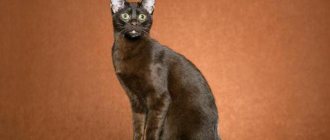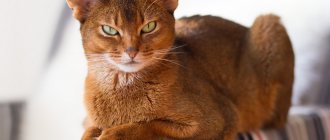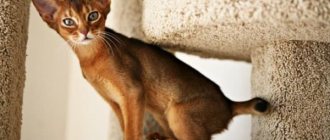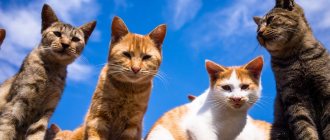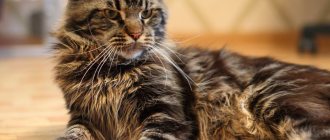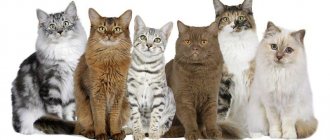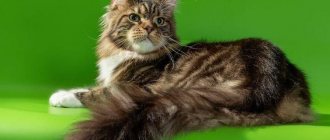Cats are sweet creatures that give a person boundless love and affection and fill his home with warmth and tranquility. However, many do not like these animals due to the fact that they shed very much; often severe allergies develop on their fur, which can lead to many health problems.
In addition, wool can remain on upholstered furniture, things, clothes, and cleaning it is not such an easy task. For this reason, cats that do not shed have become very popular recently. Many of them do not have such a pretty appearance as their long-haired counterparts, but they still have many advantages, so they are often kept in a city apartment or house.
Features of shedding in pets
Shedding is a natural process accompanied by the loss of dead hairs. In the wild, it is seasonal, that is, it is observed only a couple of times a year: in spring and autumn. These seasons were not chosen by chance, but because of a sharp change in temperature, forcing them to change their fur coat to a lighter or warmer one.
At home, shedding often occurs on an ongoing basis. The most intense period occurs during the heating season, when the microclimate in the house suddenly changes to warm and dry due to the inclusion of central heating.
The intensity of fur shedding depends on its structure. The highest is typical for long-haired cats and pets with thick undercoat. The latter cause the most inconvenience, because their thin fluff scatters very quickly and settles literally everywhere. It not only spoils the appearance of furniture and clothing, but also easily penetrates the respiratory tract and eyes, provoking allergy attacks.
Sphinx (Canadian sphinx)
The Sphynx is the only breed in the world that has minimal fur. They arose back in 1966 in Canada as a result of a spontaneous gene mutation. Since then, breeders have been actively breeding these animals.
Externally, the extraordinary Sphynx is a medium-sized cat with strong bones, well-developed muscles, wide eyes and overly large ears. They have virtually no whiskers, but some individuals may retain them. Due to the width of the chest, the paws of sphinxes are always widely spaced, and the limbs themselves are thin with long fingers.
Canadians are famous for their folds on the forehead, neck and limbs: even if you stretch the cat to its full length, the folds will still be present. Signs of fur are observed only in the form of fluff, which makes their skin similar to the skin of a child. This breed can be classified as one of those that sheds the least.
Interesting. The Sphynx is the only cat endowed with sweat glands, which are involved in creating color. As a result of sweating, your pet can leave greasy stains on furniture and floors.
The face of sphinxes is quite intelligent, and their facial expressions are very friendly. These pets quickly become attached to their owner, do not remember insults and cannot stand loneliness.
Which cats shed the least?
Animals that hardly shed include cats without undercoat, hairless breeds, and pets with curly coats. Unlike their counterparts, they leave behind much less fur and are also less likely to cause allergies in their owners.
Siamese-oriental group
This group includes “mustaches” from warm countries, devoid of undercoat. Among the main representatives are the following breeds:
- Siamese;
- oriental;
- Thai;
- Balinese;
- Abyssinian;
- Burmese;
- skiff-toy-bob;
- Mekong Bobtail.
The structure of the coat of Siamese-Oriental breeds is explained by the hot climate and the absence of the need to change the coat to a warmer one. Most of the cats listed are also distinguished by a short, close-fitting spine to the body. It is very easy to care for, since to remove fallen hairs you just need to run a damp hand over the cat.
Mustachioed Asians are distinguished by their graceful and elongated physique, as well as large ears and almond-shaped eyes. They are active, inquisitive and very loyal to humans. Because of the latter trait, animals can show jealousy towards other pets and demonstratively take offense at the small amount of attention paid to themselves.
Bengal
Bengal cats are notable not only for their wild spotted color, but also for their complete lack of undercoat. It falls out at 4-9 months and never grows back. Thanks to this feature, Bengals practically do not leave hair and do not require complex care.
Due to their close relationship with wild leopard cats, the character of these "whiskers" depends entirely on their generation. Pets F4-F7 are suitable for home keeping. They are raised in conditions of constant contact with humans, so imbalance and groundless aggression are alien to them.
Bengals love to chat, but they absolutely cannot stand forced affection. Violation of personal space by squeezing causes them great discomfort. Despite this, they never hurt children. Bengals prefer a hasty retreat to a safer place rather than letting out their claws.
Likoy
Lykoi are partially hairless cats, created by chance mutation. The fur on their body grows in clumps, and during molting it often falls out completely. For this reason, animals appear too thin and very shabby. Despite its slightly repulsive appearance, the Lykoi fur coat is pleasant to the touch.
IMPORTANT!
Lykoi plants are very sensitive to sunlight. Under the influence of ultraviolet radiation, their body changes its color to black.
The character of the Lykoi is close to that of a dog. They become strongly attached to their owners and zealously defend their territory. Because of this, werecats rarely find a common language with other pets.
Bald
Representatives of this group are the result of a natural mutation fixed by breeders. These include:
- Canadian Sphynx;
- Don Sphynx;
- cohona (Hawaiian hairless);
- Peterbald;
- Ukrainian Levkoy;
- bambino;
- minskin;
- elf;
- Dwelf.
All animals, starting with the Levkoy, were bred artificially through experimental matings of the Canadian and Don Sphynx with non-hairless cats.
Despite the almost complete absence of fur, all representatives of this group emit fairly strong allergens. Their glands produce large amounts of Fel D1, a protein foreign to humans, which quickly accumulates on their body.
In addition to allergenicity, the disadvantages of sphinxes include their unpleasant odor. It appears due to dirt and sweat settling on the skin. Unlike fluffy cats, hairless cats really hardly shed, but they leave behind greasy spots. Because of this, they need to be washed once every 1-2 weeks as they become dirty.
Despite some shortcomings, all “naked ones” are examples of canine fidelity and devotion. They become attached not to a place, but to a person, and it is very difficult to endure forced separation. But these cats find it easy to move to a new place of residence.
Rex
In addition to Sphynxes, rexes are considered conditionally hairless cat breeds that do not shed. Despite the diversity of species, international felinological organizations recognize only 5 of them:
- Cornish Rex;
- Devon Rex;
- German Rex;
- Selkirk Rex;
- Ural rex.
All of these representatives are united by their short wavy hair. Like the naked ones, rexes are prone to rapid contamination and do not tolerate frost well. To maintain a neat appearance and maintain health, they require exactly the same conditions: regular bathing when dirty and warm clothing for constant wear.
In addition to their appearance, all cats from this group are united by their friendly nature. “Curls” get along easily with other animals and become strongly attached to humans. They love to sit on laps and often climb onto shoulders in search of warmth and reciprocal affection.
“Rexes are also notable for their playfulness, which they successfully maintain until old age. Thanks to this feature, they get along well with children and take part in joint games with pleasure.
If we consider the representatives from the point of view of modesty, then primacy should be given to the Ural Rex. They can hardly be called intrusive, since these “mustaches” never bother about trifles and try to dose out their love, adapting to the mood of their owners.
Russian blue
A distinctive feature of representatives of this breed is a dense velvet coat of a bluish-ash color. Due to the matching length of the guard and undercoat, the Russian Blue's coat does not adhere to the body and appears very thick. Despite this, her molting is weakly expressed. The low intensity of hair loss is explained by the cleanliness of the animal and the special structure of the hairs, which are less susceptible to destruction.
IMPORTANT!
Naturally thin, Russian Blues are prone to obesity. With uncontrolled feeding, they quickly gain weight and turn into well-fed “koloboks”.
Russian Blues have a strong hunting instinct and love high surfaces. In an apartment, they conquer all available pieces of furniture, including cornices and mezzanines. Due to their lack of fear of heights—and their innate desire to catch birds and insects—Russian Blues often fall out of windows, so installing a cat guard in your home is essential for their safety.
Nibelung
Among the cat breeds that do not shed or smell, you can even find fluffy ones. Such an exception is the Nibelung, which strongly resembles the Russian Blue in appearance. The thick coat of this cat hides graceful and harmonious proportions.
INTERESTING!
All Nibelungs are born with yellow eyes, but by the age of 2 years, the color of their irises changes to rich green.
The coat of the Nibelung is thin and soft. The elongated hairs form a luxurious thick “collar” and “pants” on the neck and hips. The coat of animals is not prone to matting and, with proper care, practically does not interfere with its loss.
Nibelungs have a hard time with loneliness, but are truly attached to only one owner. They spend most of their time with him, so the “favorite” is always easy to recognize by the cat’s behavior.
Due to their phlegmatic temperament, furry Nibelungs are suitable for older people. A noisy atmosphere and loud sounds make them nervous, so communication with small children often ends in dissatisfied rumbling and scratching.
Breeds with low shedding
Shedding is a natural phenomenon in the life of every pet, inherent in nature itself. The ability to shed its fur and acquire a new coat allows the cat to prepare for cold or warm climates and easily tolerate significant temperature fluctuations.
All cats, regardless of breed, are subject to shedding, but there are animals that shed very little. Hairless and short-haired cat varieties not only shed less, but also have virtually no odor, which is ideal for people who cannot tolerate unpleasant odors. These breeds include Sphynxes, Peterbalds, Don and Canadian Sphynxes, Devon Rexes, Cornish Rexes, Siamese and Oriental cats.
Are there any cats that are completely non-shedding?
Such animals do not exist. A small fluff is present even on the body of naked-born sphinxes. The only difference is the intensity of its dropping.
If you adopted a kitten at the beginning of spring or autumn, but it still does not leave hairs behind, do not rush to rejoice. In childhood, this process begins no earlier than 6-8 months, but it is the longest in life. After shedding the old fuzz, denser and stiffer hairs grow on the kitten’s body, changing the richness and clarity of the color.
Peterbald
The Peterbald or St. Petersburg Sphynx is a relatively young breed, obtained in the 90s of the last century as a result of crossing the Don Sphynx and an Oriental Shorthair cat.
Representatives of this species have the following exterior characteristics:
- slender, muscular body;
- wedge-shaped head, narrow muzzle, long neat nose, almond-shaped eyes, large wide ears with pointed tips;
- long graceful limbs, thin, very long tail;
- the color can be completely different.
Peterbalds are classified into the following groups: hairless (completely hairless), flock (short fluff), velor (wool 1-5 mm long) and brush (hard curly wool). Over the years, the fur may disappear.
Unlike other breeds, St. Petersburg Sphynxes require special care. They constantly cry, especially when eating, so the skin and eyelids should be wiped with napkins or cotton pads. In addition, bare skin secretes a red-brown secretion that can only be washed off with baby oil (in no case with shampoo).
Peterbalds are very loyal to all family members and are completely devoid of aggression and rancor. However, when they play too much, they may slightly bite or scratch their owner.
Cornish Rex
The Cornish Rex breed is often called alien cats due to their unusual appearance. The structure of the fur coat of these short-haired pets resembles astrakhan fur, since waves of different depths and widths are dispersed throughout the woolen blanket. Their large mysterious eyes and huge ears also attract special attention.
The color palette of the breed includes many colors and their combinations, asymmetrical patterns and white spots against the background of the main color.
This is interesting: How to pass a job interview
The character of Cornish Rex creatures has a lot of positive aspects:
- friendliness and affection for the owner;
- sociability and high activity;
- perfect memory and desire to help the owner in daily affairs.
Due to their high mobility, these creatures have a gigantic appetite, destroying huge amounts of food. In view of this feature, it is necessary to monitor the diet of such a cat, otherwise it will gain excess weight.
Cornish Rexes are a very healthy cat variety. With sufficient care and constant activity, these animals can live up to 20 years or longer. From 16 weeks of age, kittens must be taught to bathe, since the amount of hair is not enough to absorb sebaceous secretions, which can lead to the development of skin diseases.
Devon Rex
These unusual pets appeared in England in 1959, surprising with wavy shaggy curls and thin, sometimes bald, suede-like hair. These cats cannot be called large: males can grow up to 3.6-4.5 kg, and females - up to 2.3-3.2 kg. They shed just like other cats, but the lack of guard hairs makes the shedding less noticeable than in other breeds.
The peculiarity unique to this species is an expressive and surprisingly meaningful look. These cats constantly change their facial expressions: from lovingly romantic to proudly offended, which gives them a fabulous look.
Representatives of the Devon Rex breed can be of different colors, but there is no matching color of coat and eyes. The exceptions are the color point color, which is characterized by blue eyes, and the color of Tonkinese cats with aquamarine eyes.
Cats of this English breed are very smart, easily remember nicknames and are trainable. They are very affectionate towards their owner, which cannot be said about their brothers: Devon Rex cats can even be at enmity with some cats.
These pets need to be bathed frequently because the secretions of the sebaceous glands are poorly absorbed by the short hair, and the animals quickly become dirty and sticky.
Russian blue
The cat is known for its characteristic silver color. The eyes must have a green tint. The fur is very thin and short, making the animal look quite neat.
Reviews from the owners say that these are incredibly gentle and touching creatures. The cat will never show signs of aggression; on the contrary, it is extremely affectionate.
Siamese
This breed is quite fluffy. However, they shed much less than other pets. Siamese cats have thin and short hair that falls out relatively rarely. You can further reduce shedding by brushing your Siamese weekly with a fine-tooth comb.
Mekong Bobtail
The lack of a distinct odor in representatives of this breed has a genetic cause.
Mekong Bobtails are excellent hunters, capable of tracking prey for hours and the presence of even the slightest scent would give them away.
Pets have short and smooth fur. Bobtails take good care of themselves, which allows them to always be clean. This breed does not mark territory and does not cause problems due to its coat.
A distinctive feature of bobtails is a very short tail, which is not typical for other cat breeds.
Burma
This breed looks quite impressive compared to the Oriental. It is difficult to confuse them with each other. The color is usually cream, lilac or dark brown. The physique is dense, stocky. The fur is very short. The Burmese is a physically strong and strong cat that practically does not shed. It does not require special care. Reviews from owners indicate that this is a companion cat. She prefers to spend all her time next to her loving owner.
The most important thing for her is gentle, caring hands, affection and attention. The character of the animal is marked by self-will, but it is unlikely that it will do mischief on purpose. If your pet is left alone for a long time, he will begin to get bored and make a complaining voice. It is better for the owner to try not to let this happen. Burmese categorically cannot stand loneliness. It’s better to pay more attention to her and pick her up more often.
Don Sphynx
The birthplace of the Don Sphinx is Rostov-on-Don. In 1987, a hairless cat was picked up on the street and was treated for baldness for a long time and without success. In fact, the lack of hair turned out to be a consequence of a gene mutation, and breeders began to form a new breed.
Externally, the Don Sphynx is characterized by:
- strong muscular body, often pear-shaped;
- wedge-shaped head, folded forehead, “masculine” chin, straight nose, large ears with rounded tips, medium-sized almond-shaped eyes, curly mustache (may be completely absent);
- long graceful paws with elongated toes, a long straight tail with a rounded end.
The weight of adult gentlemen reaches 7 kg, and ladies grow no more than 5 kg. Any color is allowed: black, white, red, red, gray, blue.
Representatives of the breed are very playful and enjoy new toys, like little children. They are not jealous at all and get along easily with other pets. Despite all their friendliness, these cats are very touchy.
Attention. Some people mistakenly believe that the absence of hair in an animal is a sign of hypoallergenicity. In fact, the main culprit of allergies is a glycoprotein found in cat saliva.
We offer you to read the full article on the Don Sphynx cat breed.
Turkish Angora
This is one of the most ancient and beautiful cat breeds. Most of these noble beauties are white, but there are also pets with “gray” hair. They don't shed much, which is great! After all, there is nothing more tedious than endlessly collecting white wool from everything around - from clothes to furniture. These cats have a very interesting and active temperament and enjoy playing and having fun with their owners.
Popular sphinxes
Which cats don't shed? This question is most often of interest to those who suffer from certain allergic diseases. This is an almost hairless breed, since Canadians either have no hair or can be up to 2 mm long, resembling a pile. The first Sphynx appeared in 1966, when an ordinary cat with hair in Canada gave birth to completely hairless kittens.
The Peterbald, or St. Petersburg Sphynx, has no fur. Its skin resembles a rubber surface, differing in sensitivity to the sun. Among the completely hairless cats, one can highlight the Don Sphynx.
Bombay
© shutterstock
Bombay cats are strikingly beautiful and resemble panthers with their black, smooth fur. These cats are very affectionate and have a temperament that is often compared to that of a dog. They enjoy human interaction and enjoy being walked on a leash (yes, really!).
If you're allergic to cats but can't bring yourself to live without a feline friend, don't worry! Choose one of these 10 breeds that shed less than most, and you just might find yourself a kitten worth loving that doesn't cause the sneezing and itchy eyes that come with cat ownership.
Posted by Christian Adams An American expat living in Metro Manila, Philippines for over a decade, Christian is a lifelong cat lover and the proud father of two rescue cats, Trixie and Chloe. Both girls used to be among the crowds of homeless people who roam the cities and countryside. Three-year-old Trixie was rescued from a litter found under a neighbor's porch, and two-year-old Chloe was brought home by Christian's young son, Henry, who discovered the crying kitten in the parking lot.
Siamese-oriental group
The most profitable options from the Siamese-Oriental group for a person who does not want to deal with the fact that his pet has begun to shed intensively are the following breeds:
If cats belonging to these groups begin to shed heavily, then an urgent need to look for the cause, since such a phenomenon cannot be called normal. The most common factors are:
In this case, it is best to show your pet to a doctor who can dispel doubts and, if necessary, recommend a normal treatment regimen and measures. After their use, the animal should stop pathologically shedding.
